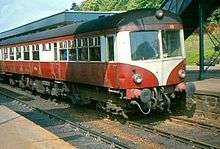British United Traction DMUs

The British United Traction produced various diesel multiple units.
Early British Railways DMUs
| British Rail British United Traction | |
|---|---|
| In service | 1953 - 1962 |
| Number built | 11 |
| Formation | 2-3 car units |
| Operator(s) | British Rail |
| Specifications | |
| Prime mover(s) | 9.6-litre, 125 bhp (93 kW) AEC.--------- 9.8-litre, 125 bhp (93 kW) Leyland 11.3-litre, 150 bhp (110 kW) AEC. ------- 11.1-litre, 150 bhp (110 kW) Leyland. 15-litre, 230 bhp (170 kW) Leyland/Albion |
BUT produced 11 lightweight diesel multiple unit vehicles for British Railways during the 1950s, numbered 79740–79750 with an M at the beginning. the first units finished in 1952. When they finished being reviewed by British Railways, British Railways took them into stock in 1953. They were of three different types of rail cars (DMS, DMBS (containing a compartment for the guard) and TS), and could be made up into two- or three-car units. The first units were fitted with skirts covering their underframes and wheels; they were later removed. They were not very successful so they were all withdrawn by 1962, so never received TOPS classification.
| Year Built | DMS cars | TS cars | DMBS cars |
|---|---|---|---|
| 1953 | 79740 | 79741 | 79742 |
| 1955 | 79745 | 79746, 79747 | 79743, 79744 |
| 1957 | 79748 | 79749 | 79750 |
First-generation DMUs
BUT also built the powertrain for the majority of British Rail 'first generation' DMUs.
Engines
The engines mainly had six horizontal cylinders and were made in several sizes:
- 9.6-litre (590 cu in), 125 bhp (93 kW) AEC.--------- 9.8-litre (600 cu in), 125 bhp (93 kW) Leyland.
- 11.3-litre (690 cu in), 150 bhp (110 kW) AEC. ------- 11.1-litre (680 cu in), 150 bhp (110 kW) Leyland.
- 15-litre (920 cu in), 230 bhp (170 kW) Leyland/Albion.
AEC and Leyland engines were those designed and built by the respective companies and were not badge engineered except for BUT badges. Six- and eight-cylinder Rolls Royce diesel engines were also used. The first post-war lightweight DMUs 1954-1969 are reputed to have had pre-war Leyland 8.6-litre horizontal diesel engines fitted. It would be nice to have this confirmed.
Turbo-charged versions of the 11.3-litre (690 cu in) and 15-litre (920 cu in) engines were available, boosting the power outputs to 200 bhp (150 kW) and 275 bhp (205 kW) respectively. The turbo-charged versions were not used by British Railways, but they were used by Ulster Transport Authority.
Some engines were badged AEC, some Leyland and some Leyland-Albion.
Engines were genuine AEC or Leyland, each type carrying B.U.T. badges.
Transmission systems
Most units had Standard Mechanical Transmission. This comprised a fluid coupling, a freewheel and a four-speed epicyclic pre-selector gearbox. The freewheel facilitated gear-changing and also had an important safety function. If an engine seized, the freewheel would disengage and give protection against transmission damage and possible derailment.
A small number of units had hydraulic transmission, using a torque converter.
Coupling codes
The level of standardisation achieved with BR's first generation DMUs was much higher than it is with modern DMUs. All had side buffers, screw couplings and vacuum brakes and the majority had the standard Blue Square coupling code system for control of engine speed and gear-changing. There were some units with non-standard coupling codes but they were a small minority. The coupling codes were:
- Blue Square, standard mechanical transmission
- White Circle, early mechanical transmission
- Yellow Diamond, early mechanical transmission
- Red Triangle, hydraulic transmission, Lysholm-Smith (Leyland) torque converter
- Orange Star, hydraulic transmission, Twin Disc (Rolls-Royce) torque converter
Non-BUT engines
Some first generation DMUs were fitted with Rolls-Royce engines. Three types were used:
- Six-cylinder, 180 bhp (130 kW)
- Six-cylinder supercharged, 230 bhp (170 kW)
- Eight-cylinder, 238 bhp (177 kW)
The six-cylinder engines usually drove through standard mechanical transmissions, but the eight-cylinder engines were usually coupled to Twin-disc (Rolls-Royce) torque converters.
Mixed running
Rolls-Royce devised a system which enabled DMUs with mechanical and hydraulic transmissions to work together. The British Rail Class 127 units were fitted with this system and given the standard Blue Square coupling code, instead of the Orange Star code given to the British Rail Class 125 units.
There was a gear-change lever (marked D-3-2-1) on the driver's desk and it worked as follows:
- Hydraulic stock only: the lever was moved to "D" and no gear-changing was necessary
- Mixed mechanical and hydraulic stock: the driver changed gear as normal (with "D" corresponding to fourth gear) and the gear-change signals were ignored by the units with hydraulic transmission
It was a good idea but it created problems in practice. If the mechanical stock was at the back, the driver might forget to change gear, and this could lead to gearbox damage. In 1969 (after a serious accident in 1968) the Class 127s were re-labelled with the (then disused) Red Triangle coupling code, and mixed running was discontinued.
See also
External links
The Railcar Website was refurbished during 2011.